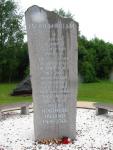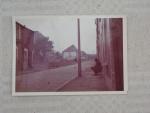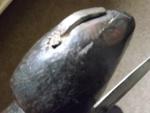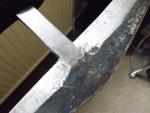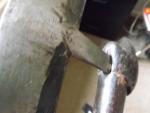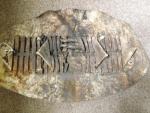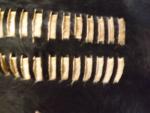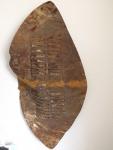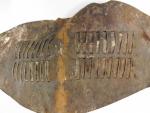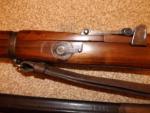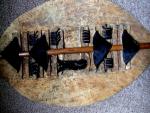-
Posts
69 -
Joined
-
Last visited
-
Days Won
2
Content Type
Profiles
Forums
Blogs
Gallery
Events
Store
Everything posted by Harry the Mole
-
.thumb.jpg.57f309a664b54aa681e291065b58838e.jpg)
boer war helmet ?
Harry the Mole replied to blueman's topic in Great Britain: Militaria: Badges, Uniforms & Equipment
The helmet is probably earlier than the Boer war. And for paul R's benefit, they are made of cork and covered in cloth. It was customary to coat these helmets with a white blanco, that is the cracking that can be seen on the surface of the cloth. But when on oveseas service they were often stained with tea. -
A quick update on my recent posting of the rather battered Zulu shield. After some thought, I decided to have a go at doing a bit of restoration to the shield. My daughter advised me against it - she preferred it as it was. But knowing the type of person I am, I couldn't resist seeing what could be done. After finding a suitable container - I wasn't allowed to use the bath, I soaked the shield in warm water for the best part of five hours. By then it had become quite floppy, and before going any further I laid it out on a large plastic sheet and inserted a replacement pole which I obtained from a tree in my front garden. I straightened out the hide as best I could and sandwiched it between two boards while it dried out. The pictures are of the end result. http://gmic.co.uk/uploads/monthly_03_2013/post-15217-0-58327300-1363864752.jpghttp://gmic.co.uk/uploads/monthly_03_2013/post-15217-0-15900500-1363864788.jpg
-
I still have many of my 'wanted' lists of pictures which we all carried around in our granny-books. I still have my diaries which I kept too. And now I am being told that some of the things I experienced didn't happen. I guess I must have made it all up. You try to forget some things, but they have a habit of coming back to haunt you in later life.
-
'Operation Banner' was the longest campaign in British military history. Out of all the campaigns which have taken place over the past 50 years it is probably the one that attracts the least amount of discussion amongst military historians. Every year I sell poppies for the RBL, and I am often asked what my medal is for. And when I say 'Northern Ireland' it never ceases to amaze me the amount of ignorance shown by people on the subject. Many seem to have the this idea that not much really went on over there. They are under the impression that only a 'few' soldiers lost their lives. There were often multiple casualty incidents - such as Warrenpoint on the 27th August 1979. In a double bomb blast, 16 members of the Parachute regiment, along with two other soldiers from another unit lost their lives. Our enemy didn't wear a uniform. You could be ambushed one moment and have the same person walk past you the next. Your enemy looked just the same as your friend. And yet this 'war' wasn't classed as a war by the British Government. It was merely 'Civil Unrest.' There were no homecoming parades through the streets. No repatriation ceremonies with guard of honour for our dead comrades. They were just quietly brought over without causing a fuss. There was none of this talk on the news of the latest casualty being 'the best' or 'an inspiration to his comrades.' It was usually just a case of... 'Another soldier was shot dead today by an IRA sniper while on patrol in Belfast. His family have been informed.' We are supposed to have been at peace now since 2001. But when I wrote a book about my experiences in Northern Ireland, and it was submitted to the Ministry of Defence for clearance, I was advised to change peoples identities 'Due to the on-going security situation in Northern Ireland.' It doesn't sound like much of a peace if events of 40 years ago can still be a security problem does it? There must be other former soldiers who like me served in Ireland, and also use this forum. I would be interested to hear their opinions on why our efforts to keep the peace on the streets of Northern Ireland have never got the recognition we so richly deserve.
-
.thumb.jpg.57f309a664b54aa681e291065b58838e.jpg)
British Spitfire hunter
Harry the Mole replied to Hugh's topic in Great Britain: Militaria: Badges, Uniforms & Equipment
None of this ever made sense to me. Why would the military go to the trouble of digging massive pits in the ground to bury aircraft, when all they had to do was blow them up to put them beyond use? It all smacks of just another urban myth. -
Hi Mervyn - and thanks again for the information. The points you mentioned on the larger shield are only what I thought anyway. There were never any spurious claims made about its origins - I was just told it was probably tourist, and probably 1920's or later. Saying 'later' can actually cover a rather long period of time! I have compared the head of the axe to the metal used on my spears, and I cannot really see any difference. It is probably just the effect of my camera that makes the metal look so shiny. In hand it looks totally different. I have also taken some pictures of the back of the older shield. The hide is around 5mm thick. best regards, Steve. http://gmic.co.uk/uploads/monthly_03_2013/post-15217-0-54418800-1363271823.jpghttp://gmic.co.uk/uploads/monthly_03_2013/post-15217-0-40428000-1363271852.jpghttp://gmic.co.uk/uploads/monthly_03_2013/post-15217-0-58932900-1363271868.jpghttp://gmic.co.uk/uploads/monthly_03_2013/post-15217-0-40582900-1363271891.jpg
-
My second shield is supposedly an isihlangu. The hide measures 51 X 22 inches. It is just something I picked up in exchange for a few odds and ends I was disposing of. The pole that was affixed to it was nothing more than a length of pine curtain pole with a bit of fox-fure stole stuck on the top. I replaced the pole with a suitable tree-branch which I stripped and cleaned. I was told that the shield was probably a tourist piece and (probably) from the 1920's or 30's. I am not so sure, but it displays rather well. The sheen to the back of the shield is down to my wife putting some beeswax polish on it. She thought she was doing me a favour! The shape of the shield looks rather odd on one side, but this is purely down to warping of the hide. http://gmic.co.uk/uploads/monthly_03_2013/post-15217-0-68810200-1363259267.jpghttp://gmic.co.uk/uploads/monthly_03_2013/post-15217-0-73285300-1363259289.jpghttp://gmic.co.uk/uploads/monthly_03_2013/post-15217-0-22836700-1363259313.jpghttp://gmic.co.uk/uploads/monthly_03_2013/post-15217-0-01437300-1363259322.jpg
-
Lovely weapons Terry. I am rather new to this period of conflict, and my own Martini Henry Mk11 was made a bit late to have seen use in the Zulu wars. I am gradually getting together a rather nice small collection of Zulu artefacts though. My latest finds are a rather battered old shield and axe. The shield would have been 14 X 28 inches were it not for the warping. The woman who sold it to me said it was a dance shield, but I thought they were smaller than this. What remains of the hair is light a dark brown. The axe has a shaft of 18 inches, and the blade is 11.5 inches. I was told it was made around the 1920's. I have another shield which I will list seperately.
-
Very nice examples Terry. I have always been a fan of the Lee Enfield. In my humble opinion - the finest bolt action military rifle ever made. I enclose a couple of views of my Enfield-made SMLE No.1 Mk111. This particular example was made in 1912. It was an absolute dog when I originally purchased it last year. I spent some time converting it back to full Mk111 status. The P1907 bayonet pictured with it was one I found at a local car boot last year. It is November 1914 dated, and marked to 3rd Battalion Welsh Fusiliers. http://gmic.co.uk/uploads/monthly_03_2013/post-15217-0-79072100-1362685951.jpghttp://gmic.co.uk/uploads/monthly_03_2013/post-15217-0-77797000-1362685967.jpghttp://gmic.co.uk/uploads/monthly_03_2013/post-15217-0-67076700-1362686001.jpg
-
I was always under the impression that the Rifle, Magazine, Lee Enfield Mk1 was actually adopted for military use in 1895. It was the Rifle No.1, Short, Magazine Lee Enfield Mk1 which was adopted in December 1902 - a completely different rifle from the earlier pattern. Many of the earlier long Lee Enfields were later converted to SMLE N0.1 Mk11(CNVD). London Small Arms & Co had a reputation for high quality rifles - even the one's they made for the military. I own an Martini Henry Mk11 which was built by LSA for the miitary in 1888. This is quite a late date for a Mk11. A simplified version of the SMLE was introduced in 1916 - the Mk111*. This didn't have the magazine cut-off and volley sights of the earlier Mk111. But examples made by LSA & Co AFTER 1916 do turn up with the volley sights and cut-off still in place.
-
Thanks to you both for the comments. The spear with the weighted end is superbly ballanced. I think the only way of knowing the age of anything is by having concrete evidence about where it came from, and how it was originally obtained. I once owned a Mauser Mod 71 which had been dug up in an african desert in the 1920's. It had hung on the wall of a large house in Lymm - not far from where I live since it had been found. A gunsmith friend of mine gave it to me when he was retiring. And it had originally been given to him by the person who found it. regards, Steve.
-
Hello Mervyn, Many thanks for replying to my post. Collecting Zulu items is something rather new to me. The top spear in the original pictures came with the shield and a knobkerry. I was told by the dealer that the metal on the end of the spear came from an 1880's period ammunition box. I pointed out to the seller that as far as I knew the wooden boxes were bound with copper strips. So then he suggested it must have come off the actual waggons the British Army used at that time. I din't buy the story, but I did like the items! The shield isn't really as good as it looks in the pictures. There is some hair loss, and the back is much dirtier than the pictures suggest. All I know about it is that it turned up in a house clearance some years ago. Not that it means anything though. I certainly didn't think it was an old piece, but it does display rather well. You probably know how it is with collecting. You take an interest in something, and suddenly they appear everywhere! The lower two spears in the original pictures were purchased from a dealer here in England last week. I took a gamble and paid £270 for both. They were advertised as throwing spears, although when I got them I thought (hoped) that the shorter of the two might have been an 'iklwa.' It just seemed a bit short at 45 inches for it to be a throwing spear. But what do I know? Last Saturday I was at a local flea market and spotted another spear amongst all the junk. I have posted some pictures of it along with the knobkerry I got with the Shield. The club has a length of 28 inches. The ball is 2.5 inches in diameter. The spear is overall 50.5 inches, and the blade is 13.5 inches including the 1 inch haft. Any information you can give me will be greatly appreciated. I am not really concerned about values. Something is only worth what someone is prepared to pay! But I would be interested to know how old they might be. Cheers, Steve. http://gmic.co.uk/uploads/monthly_02_2013/post-15217-0-00147200-1361912604.jpghttp://gmic.co.uk/uploads/monthly_02_2013/post-15217-0-26210700-1361912617.jpg
-
Could anyone help me identify these spears? I am told that the upper spear in the first picture is a throwing spear. The blade is 12 inches long, and the end of the shaft has been balanced with a strip of metal wrapped around. The total length is 53 inches. The second spear has a blade length of 9 inches. The haft is 3 inches. Total length is 47 inches. The haft is held in place with intricately bound brass and copper wire. The third spear appears to match descriptions of the iklwa. But having little knowledge on the subject, I really do not know for sure. The blade is 10 X 1.5 inches and the haft is 6 inches. The total length is 45 inches. I remember reading somewhere a description of the iklwa, and it was stated the the spear was 'absolutely no longer than 40 inches. The shield measures 24 X 14 inches. It does show some age, and I do not believe it to be a tourist piece. The original stick was missing. I replaced it with a very old cut-down walking stick. Many thanks in anticipation, Steve. http://gmic.co.uk/uploads/monthly_02_2013/post-15217-0-87818500-1361533546.jpghttp://gmic.co.uk/uploads/monthly_02_2013/post-15217-0-71862900-1361533568.jpghttp://gmic.co.uk/uploads/monthly_02_2013/post-15217-0-43383500-1361533597.jpghttp://gmic.co.uk/uploads/monthly_02_2013/post-15217-0-82800400-1361533637.jpghttp://gmic.co.uk/uploads/monthly_02_2013/post-15217-0-43423100-1361533653.jpghttp://gmic.co.uk/uploads/monthly_02_2013/post-15217-0-02417900-1361533714.jpghttp://gmic.co.uk/uploads/monthly_02_2013/post-15217-0-00394400-1361533744.jpg





